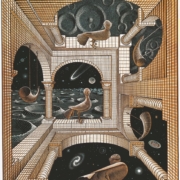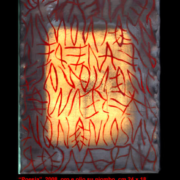Introduction Adolescents, group and new representations at the time of the internet
“…and it was during that time that the city began to hear about the Captains of the Sands, abandoned children who lived by stealing. No one ever knew the exact number of children who lived that way. There were at least a hundred, and more than forty of them slept in the ruins of the old warehouse.
Dressed in rags, dirty, half-starved, aggressive, cursing, and smoking cigarette-butts, they were, in truth, the masters of the city, the ones who knew it completely, the ones who loved it completely, its poets.” (Amado, 1937).
Thus, almost a century ago, Jorge Amado described a typical presence of Brazilian metropolises, meninos da rua, bands of street children abandoned by poor and marginalized families. Because of their state of neglect and abject poverty, their group was (and in some cases still is) their strength, a family with well-defined rules, values and organization, permeated by a strong sense of belonging sealed by a hostile world which, urged by a need for consumerist progress, has no room for them.
Meninos da rua were preadolescents and adolescents, as are hikikomori who, at the turn of the millennium, live in complete isolation from twelve years of age onwards. Hikikomori confine themselves to their homes and spend their time surfing the internet to avoid any activity which could even remotely become the object of adults’ or their own expectations. Is the peer group, the band or the street group being replaced by isolation caused by being always virtually connected?
This issue of Funzione Gamma focuses on the large and kaleidoscopic horizon characterizing the very specific human age called Adolescence. The catastrophic change, to use Bion’s words (1966), occurring at this age turns adolescence into a kind of virtual time with great potential not yet or immediately realized. A child who becomes an adolescent is comparable to a wayfarer who, after an arduous journey uphill, reaches the top of a mountain and sees a huge valley opening below him, like an immense and unknown space to be explored and experienced. Bewilderment, solitude, fear, but also fascination, determination and courage are the feelings arising from this view.
Although adolescence is seen as a specific phase with specific characteristics, anguishes and defense modes, this issue includes various contributions providing different perspectives to investigate contemporary adolescence at the time of the internet as “a third challenge”, to quote Ferrari (1994). What is adolescence, and, more specifically, what is adolescence today? Are its characteristics unchanged in a contemporary world so profoundly changed by new knowledge and communication tools, or are these tools generating new representational worlds?
Tisseron’s contribution on the meaning of the virtual and the potential as a condition of psychism introduces the problem of hikikomori adolescents by using a questioning approach rather than a definition, envisaging possible interpretations of and treatment methods for adolescents during their evolution at the beginning of their ontogenetic task.
Various perspectives will be presented, from the observation of groups of adolescents “networking” to the use of videogames within an analytic experience with an adolescent; from the use of a smartphone in an art-therapy group with adolescents to helping adolescents who begin group therapy detach from technological objects, and inviting them to discuss the implications of this detachment; from a service dedicated to adolescents who request it spontaneously or through their parents to the implications of an adolescent’s evolution on his parents and family; from the functions of imagination explored through images of adolescent groups in films to building group narrations in therapeutic settings with adolescents.
The common element of all the perspectives explored is the awareness that this human way of being is so specific and particular that it requires special attention and profound respect. In general, the need to create a “loose shelter” where adolescents can learn by doing, since at this age more than ever doing is necessary to know. Indeed, all the contributions underline the need to let adolescents experiment with the implications of becoming what they are becoming.
In this regard, special attention should be placed on retreat and isolation – used by adolescents to defend themselves from the blinding light of their new body with its new forms, sensations and perceptions – leading to what Ferrari defines proto-depression, which may turn into real depression if it is not resolved immediately at this time of life. The elements to face are, therefore, numerous for those who work with this age of human life.
What is the role of a changing body in the fluctuations between on line and off line? Is it censored, exposed or represented differently? How does its repossession and symbolic reorganization – which are so necessary for the individuation of adolescents – take place? Do – and how – new technologies influence identity-building that occurs in a relational and inter-subjective matrix and depends on the ability to process emotions and feelings? (Fonagy and Target, 2001; Williams 2015) And do and how reciprocity and intimacy change in relationships? Is there a statute of “technological bonds” characterized by their being virtually real? (Turkle, 1996)
Another central aspect when working with adolescents is the ability to identify and distinguish the many functions served by the group. Is the group a resource, a protective incubator for an emerging individual or a den to hide in to postpone the acceptance of one’s own unknown evolution?
Does being constantly connected – through a smartphone, internet, facebook, etc. – change one’s self-representation? Does it mitigate the sense of solitude typical of this age? Is it a new form of group life or does it increase adolescents’ isolation in their illusory world? The role that new technologies can play in treatment is particularly relevant today. How should a setting be modified to enhance clinical work with adolescents? What are the boundaries between break-ups and acting out – both by adolescents and therapists – and creative innovation?
Rather than providing answers to these questions, there is a need to spur reflection on this crucial phase of life, as adolescents are expected to do as captains of “virtual sands”, provided that also therapists succeed in handling anguish, curiosity about novelties, change and the unknown.
We wish to thank all the authors who contributed their precious articles. A special word of thanks goes to Professor Stefania Marinelli for providing us with the opportunity to edit this issue of Funzione Gamma.
References
Amado J., (1937), Capitães da areia, Rio de Janeiro, Editora Record LTDA, Italian translation Capitani della spiaggia, Milan, Garzanti 2007. English Translation Captains of the Sands, New York, Penguin Books 2013.
Bion, W. R. (1966), Catastrophic change, Bulletin of the British Psychoanalytical Society, 1966, No. 5, Italian translation (1981) Il cambiamento catastrofico. La griglia, caesura, seminari brasiliani, intervista. Turin, Loescher, Collana: La Sfinge. Collana di psicoanalisi.
Ferrari, A.B. (1994), Adolescenza: la seconda sfida, Rome, Borla.
Fonagy, G. Gergely, E.L. Jurist, M. Target, (2005), Mentalization, Affective Regulation and the Development of the Self, Paperback 2005.
Turkle, S. (1996) Virtuality and its Discontents-Searching for Community in Cyberspace, www.prospect.org/archives/24/24turk.html.
Williams R. (2015), The Social Roots of Human Identity and the Interplay 3 of the Selves, Rivista Internazionale Di Filosofia e Psicologia. http://www.rifp.it/ojs/index.php/rifp http://www.rifp.it







